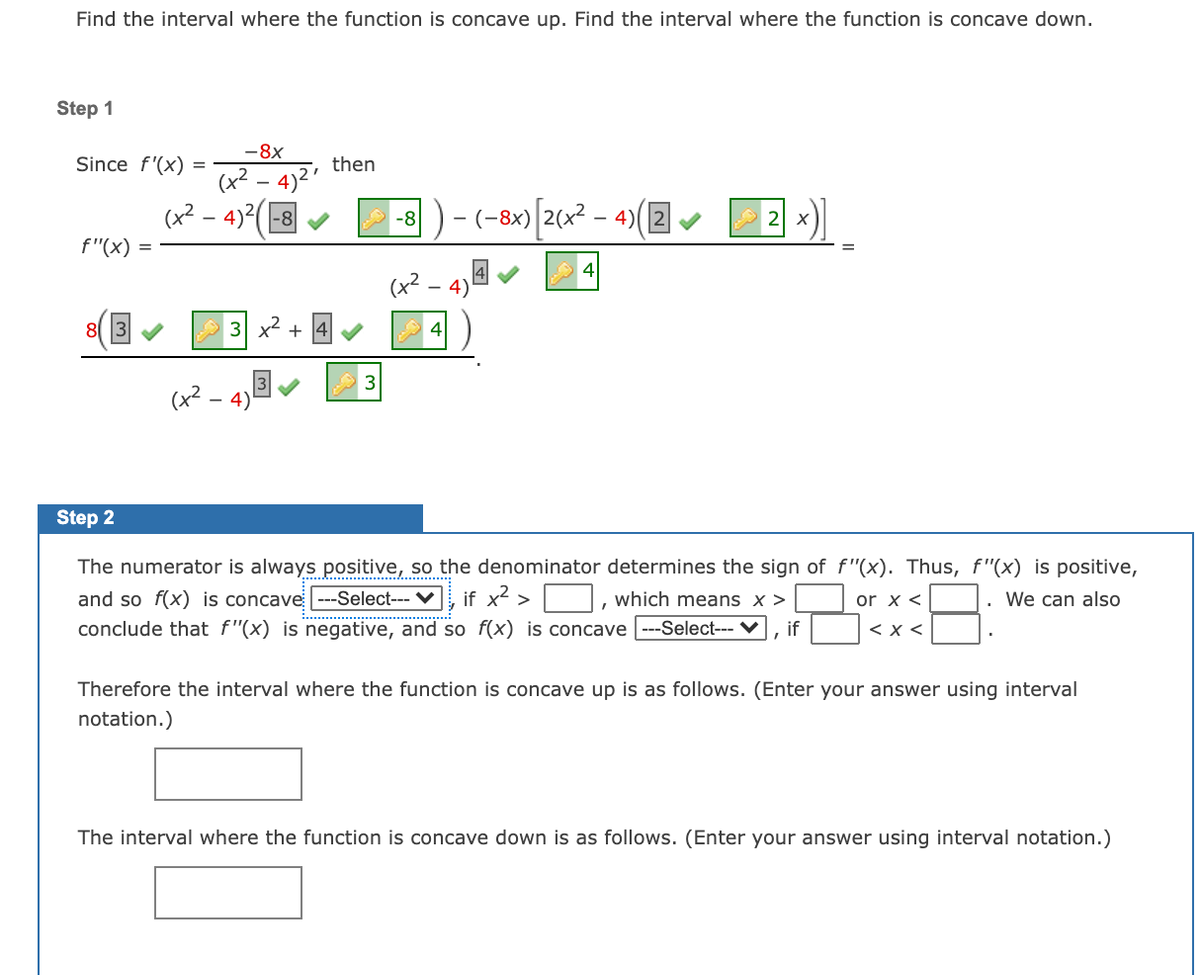The numerator is always positive, so the denominator determines the sign of f"(x). Thus, f"(x) is positive, and so f(x) is concave ---Select--- ♥ if x² > conclude that f"(x) is negative, and so f(x) is concave --Select--- ♥ h..... .... which means x > or x < We can also if < x < Therefore the interval where the function is concave up is as follows. (Enter your answer using interval notation.) The interval where the function is concave down is as follows. (Enter your answer using interval notation.)
The numerator is always positive, so the denominator determines the sign of f"(x). Thus, f"(x) is positive, and so f(x) is concave ---Select--- ♥ if x² > conclude that f"(x) is negative, and so f(x) is concave --Select--- ♥ h..... .... which means x > or x < We can also if < x < Therefore the interval where the function is concave up is as follows. (Enter your answer using interval notation.) The interval where the function is concave down is as follows. (Enter your answer using interval notation.)
Functions and Change: A Modeling Approach to College Algebra (MindTap Course List)
6th Edition
ISBN:9781337111348
Author:Bruce Crauder, Benny Evans, Alan Noell
Publisher:Bruce Crauder, Benny Evans, Alan Noell
Chapter2: Graphical And Tabular Analysis
Section2.1: Tables And Trends
Problem 1TU: If a coffee filter is dropped, its velocity after t seconds is given by v(t)=4(10.0003t) feet per...
Related questions
Question
100%
Please explain step 2 clearly, this is my 3rd time posting the same question due to people not highlighting where the answer is..

Transcribed Image Text:Find the interval where the function is concave up. Find the interval where the function is concave down.
Step 1
-8x
Since f'(x) =
then
(x2 -
4)2'
(x² – 4)²(-8|
|-8 ) - (-8»)[2C«² – 4»(2- 2 *)
f"(x)
(x2.
4)
8 3
3
+
4
4
(x2 – 4)
Step 2
The numerator is always positive, so the denominator determines the sign of f"(x). Thus, f"(x) is positive,
and so f(x) is concave ---Select--- ♥ if x² >
conclude that f"(x) is negative, and so f(x) is concave ---Select--- ♥
which means x >
or x <
. We can also
if
< x <
Therefore the interval where the function is concave up is as follows. (Enter your answer using interval
notation.)
The interval where the function is concave down is as follows. (Enter your answer using interval notation.)
Expert Solution
This question has been solved!
Explore an expertly crafted, step-by-step solution for a thorough understanding of key concepts.
This is a popular solution!
Trending now
This is a popular solution!
Step by step
Solved in 2 steps with 2 images

Recommended textbooks for you

Functions and Change: A Modeling Approach to Coll…
Algebra
ISBN:
9781337111348
Author:
Bruce Crauder, Benny Evans, Alan Noell
Publisher:
Cengage Learning

Mathematics For Machine Technology
Advanced Math
ISBN:
9781337798310
Author:
Peterson, John.
Publisher:
Cengage Learning,

College Algebra (MindTap Course List)
Algebra
ISBN:
9781305652231
Author:
R. David Gustafson, Jeff Hughes
Publisher:
Cengage Learning

Functions and Change: A Modeling Approach to Coll…
Algebra
ISBN:
9781337111348
Author:
Bruce Crauder, Benny Evans, Alan Noell
Publisher:
Cengage Learning

Mathematics For Machine Technology
Advanced Math
ISBN:
9781337798310
Author:
Peterson, John.
Publisher:
Cengage Learning,

College Algebra (MindTap Course List)
Algebra
ISBN:
9781305652231
Author:
R. David Gustafson, Jeff Hughes
Publisher:
Cengage Learning

College Algebra
Algebra
ISBN:
9781305115545
Author:
James Stewart, Lothar Redlin, Saleem Watson
Publisher:
Cengage Learning

Trigonometry (MindTap Course List)
Trigonometry
ISBN:
9781337278461
Author:
Ron Larson
Publisher:
Cengage Learning

Algebra & Trigonometry with Analytic Geometry
Algebra
ISBN:
9781133382119
Author:
Swokowski
Publisher:
Cengage